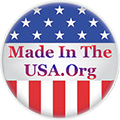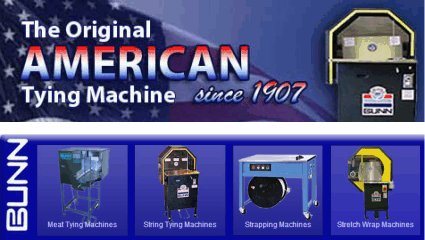One of the products Bunn sells is American Made Binding Machines. A more complete list of their products is provided by Made in America Secrets, to review their list click here.
For more information about Bunn and its Made in the USA products see the following:
It came from long, tedious hours of handling mail...from the endless stacks of envelopes and flyers to be bundled. Who wouldn't develop a notion that there had to be a better way.
This was way back in 1906. The year a hard-working postal clerk named Romanzo Norton Bunn said to his inquisitive son, why not a mechanical tying machine?pcat=master-catalog
Mr Bunn, Founder
Benjamin H. Bunn
Founder
Benjamin Bunn was an inventive sort. A teenager who liked to experiment until something came out right. And it did!
By 1907 Benjamin H. Bunn had invented a prototype of the world's original Letter Tying Automatic Turntable Two Wrap Cross Tie Machine - the number one Bunn. This concept actually ushered in the era of automatic packaging.
During his first year at the University of Illinois, Benjamin worked on the prototype in the attic of the family home at 10549 Church Street. Benjamin Left school after a year to continue working on his machine's features and improvements. By 1910 his prize prototype was fully perfected.
Postal Service Breaks the Ice
He then went on the road to demonstrate the new machine in Post Offices at New York, Washington, and Ottawa, Canada. Interestingly, the first Bunn Tying Machine was purchased by the Canadian Post Office.
In 1913, the United States Post Office purchased 50 of the new machines, as well as a number of commercial business sales. The Automatic Tying Machine was on its way.
In 1923, with a lot of foresight, optimism and confidence in the future, Benjamin H. Bunn purchased a building at 7339 Vincennes Avenue on Chicago's south side and established a complete machine shop and assembly area to handle the mounting orders for the Bunn Tying Machines. Commercial industry had beat a path to Bunn requiring all shapes and sizes of machines for general applications.
By 1930, the Bunn facility had grown and a new, larger building was built on the Vincennes Avenue site, and 12 years later an addition was made to the facility. The company's product demand and financial strength continued to grow, and the same thing happened in 1952 and 1957...more additions.
In 1946, Benjamin's son Richard B. Bunn entered the business with an energetic sales approach. From that point, an experienced organization of manufacturing representatives, totaling 25, was pulled together and strengthened nationwide, along with several Worldwide Sales worldwide.
During the 40's and the 50's, as the Bunn sales organization grew, so did the Bunn Company. Through this organization, the total product line expanded to meet the customized application requirements of numerous businesses. The Bunn response to the most unique application is, We can do it. Today, this same motto still rings true...We can do it.
In 1950, a representative of the U.S. Postal Service Research and Development Department, came to the company to request a machine that would be the first step to automated mail. And, it was.
Within the next 14 years, 11,000 Bunn tyers were in place in U.S. Post Offices throughout the country.
In 1965, anticipating the needs of industry, Bunn tested a Japanese plastic strap machine. After several years of negotiations and product feature modifications at Bunn's request, the Nichiro line of plastic strap machines were improved significantly.
In 1968, Bunn became one of 4 exclusive North American marketers for plastic strap machines. Business continued to boom and Bunn moved to a spacious plant in south suburban Alsip, Illinois, a 52,000 square foot building on a 5 acre tract that boasted 30% more production space.
In 1983, The B. H. Bunn Company marked its 75th Anniversary. Three-quarters century of business growth has made the Bunn name synonymous with package-closing equipment. With combined input from thousands of users in all phases of business, research and development, the Bunn Company can offer a complete range of tying and strapping equipment, along with accessories for virtually any bundling or unitizing application...for maximum productivity.
In 1984, B. H. Bunn Company moved again - to Lakeland, Florida. The plant's new equipment and facility resulted in dramatic savings in machining time and cost efficiency.
In 1990, the development of the new Bunn Models created a stronger and more reliable tying machine.
In 1997, John R. Bunn President, grandson of the inventor, purchased the B. H. Bunn Company from Richard Bunn to continue the tradition. Since his return, the Bunn company has continued to grow with new designs and applications exceeding customer expectations.
In 2000, the Next Generation of Bunn, Ring Tyer, machine was introduced with great strides in the market place. This newest model gives Bunn another dimensions to help customers with precision bundling far surpassing other models.
In 2004, Bunn has introduced the BUNN-LER Stretch wrapping machine. This model takes the roll out of the customers hand and increases efficiency of bundling with stretch films.
For more information about Bunn and its Made in the USA products see the following:
It came from long, tedious hours of handling mail...from the endless stacks of envelopes and flyers to be bundled. Who wouldn't develop a notion that there had to be a better way.
This was way back in 1906. The year a hard-working postal clerk named Romanzo Norton Bunn said to his inquisitive son, why not a mechanical tying machine?pcat=master-catalog
Mr Bunn, Founder
Benjamin H. Bunn
Founder
Benjamin Bunn was an inventive sort. A teenager who liked to experiment until something came out right. And it did!
By 1907 Benjamin H. Bunn had invented a prototype of the world's original Letter Tying Automatic Turntable Two Wrap Cross Tie Machine - the number one Bunn. This concept actually ushered in the era of automatic packaging.
During his first year at the University of Illinois, Benjamin worked on the prototype in the attic of the family home at 10549 Church Street. Benjamin Left school after a year to continue working on his machine's features and improvements. By 1910 his prize prototype was fully perfected.
Postal Service Breaks the Ice
He then went on the road to demonstrate the new machine in Post Offices at New York, Washington, and Ottawa, Canada. Interestingly, the first Bunn Tying Machine was purchased by the Canadian Post Office.
In 1913, the United States Post Office purchased 50 of the new machines, as well as a number of commercial business sales. The Automatic Tying Machine was on its way.
In 1923, with a lot of foresight, optimism and confidence in the future, Benjamin H. Bunn purchased a building at 7339 Vincennes Avenue on Chicago's south side and established a complete machine shop and assembly area to handle the mounting orders for the Bunn Tying Machines. Commercial industry had beat a path to Bunn requiring all shapes and sizes of machines for general applications.
By 1930, the Bunn facility had grown and a new, larger building was built on the Vincennes Avenue site, and 12 years later an addition was made to the facility. The company's product demand and financial strength continued to grow, and the same thing happened in 1952 and 1957...more additions.
In 1946, Benjamin's son Richard B. Bunn entered the business with an energetic sales approach. From that point, an experienced organization of manufacturing representatives, totaling 25, was pulled together and strengthened nationwide, along with several Worldwide Sales worldwide.
During the 40's and the 50's, as the Bunn sales organization grew, so did the Bunn Company. Through this organization, the total product line expanded to meet the customized application requirements of numerous businesses. The Bunn response to the most unique application is, We can do it. Today, this same motto still rings true...We can do it.
In 1950, a representative of the U.S. Postal Service Research and Development Department, came to the company to request a machine that would be the first step to automated mail. And, it was.
Within the next 14 years, 11,000 Bunn tyers were in place in U.S. Post Offices throughout the country.
In 1965, anticipating the needs of industry, Bunn tested a Japanese plastic strap machine. After several years of negotiations and product feature modifications at Bunn's request, the Nichiro line of plastic strap machines were improved significantly.
In 1968, Bunn became one of 4 exclusive North American marketers for plastic strap machines. Business continued to boom and Bunn moved to a spacious plant in south suburban Alsip, Illinois, a 52,000 square foot building on a 5 acre tract that boasted 30% more production space.
In 1983, The B. H. Bunn Company marked its 75th Anniversary. Three-quarters century of business growth has made the Bunn name synonymous with package-closing equipment. With combined input from thousands of users in all phases of business, research and development, the Bunn Company can offer a complete range of tying and strapping equipment, along with accessories for virtually any bundling or unitizing application...for maximum productivity.
In 1984, B. H. Bunn Company moved again - to Lakeland, Florida. The plant's new equipment and facility resulted in dramatic savings in machining time and cost efficiency.
In 1990, the development of the new Bunn Models created a stronger and more reliable tying machine.
In 1997, John R. Bunn President, grandson of the inventor, purchased the B. H. Bunn Company from Richard Bunn to continue the tradition. Since his return, the Bunn company has continued to grow with new designs and applications exceeding customer expectations.
In 2000, the Next Generation of Bunn, Ring Tyer, machine was introduced with great strides in the market place. This newest model gives Bunn another dimensions to help customers with precision bundling far surpassing other models.
In 2004, Bunn has introduced the BUNN-LER Stretch wrapping machine. This model takes the roll out of the customers hand and increases efficiency of bundling with stretch films.

